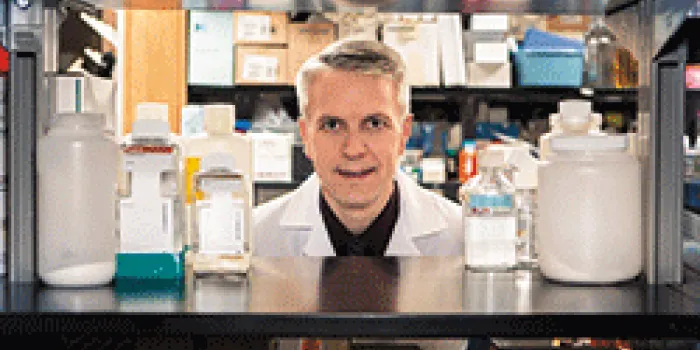“THINK BETTER. THINK BIGGER. THINK BEYOND.”
These are the themes Steven W. Pipe, MD, laid out in summer 2015 as part of his first address as chair of the National Hemophilia Foundation’s Medical and Scientific Advisory Council (MASAC). Pipe is a professor of pediatrics and pathology at the University of Michigan in Ann Arbor, and pediatric medical director of its Hemophilia and Coagulation Disorders Program.
Pipe’s confident his vision will come to pass, because ambitious goals are nothing new to the members of MASAC, a collection of 30 experts in research, patient care and public health. The council has been serving the bleeding disorders community since it was established by the National Hemophilia Foundation (NHF) in 1954. Through the succeeding decades, it has had a major role in communicating to both medical personnel and the general public.
Here’s an inside look at MASAC’s mission, inner workings, history and lasting impact.
MASAC’s Special Role
According to Pipe, the council’s primary role is to advise on treatment issues, research and other general health concerns that are important to the bleeding disorders community and, where appropriate, to issue recommendations. MASAC has issued more than 400 communications to date, covering topics from prevention and treatment to infectious disease complications and surveillance.
A crucial service the council provides is in revising its main treatment recommendation, also known as “MASAC Recommendation Concerning Products Licensed for the Treatment of Hemophilia and Other Bleeding Disorders.” This document includes a compendium of all available products that have been FDA-approved and licensed in the US for managing bleeding disorders. “Where no products are available, we provide advice on alternate treatments so clinicians don’t feel empty-handed,” Pipe explains. These guidelines are a key reference for international experts, medical schools, pharmacists, emergency room personnel, insurance companies and many others.
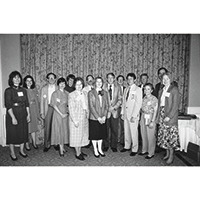
MASAC members in the 1980s.
The makeup of the council itself is carefully considered, according to Neil Frick, MS, NHF’s vice president for research and medical information. He has worked at NHF since 1998 and with MASAC since 2006. Currently, Frick serves as a direct liaison to the council, managing the distribution of the content MASAC reviews and creates.
The council includes not only physicians and scientists, but also other medical professionals with a wide range of expertise. “There are government representatives from the Food and Drug Administration (FDA), Centers for Disease Control and Prevention (CDC), National Institutes of Health (NIH), and the Maternal and Child Health Bureau (MCHB),” says Frick. Chairs of NHF’s nursing, social work and physical therapy working groups are also members. So are representatives from the World Federation of Hemophilia and the American Thrombosis and Hemostasis Network, a research organization. Patients in the bleeding disorders community also serve on the council.
Some MASAC members are elected; others are appointed. A term on the council lasts three years; members can be reappointed for a second term. “The flexibility and turnover of MASAC are what keep it a vibrant and alive organization,” Pipe says. Because the needs of the community change over time, it’s important that the group includes new members to help deal with current problems and face the future, he adds.
One such member was Nisha Jain, MD. Until summer 2015 she served on MASAC in her capacity as supervisory medical officer with the FDA. (She has since moved to a position outside government.) A pediatric hematologist/oncologist, Jain describes her former role as a liaison between the FDA and NHF. She was responsible for keeping the council updated on any pertinent happenings from the agency and conveying what it needed from the bleeding disorders community—for example, assistance with recruiting patients for focus groups.
MASAC is an invaluable organization for those with bleeding disorders, says Jain. “It’s one of the very good things about the community, that they have experts who gather twice a year to discuss all the relevant aspects in the field and what guidance to provide.” This type of council is somewhat unusual among groups connected with medical conditions, and especially for rare diseases, she adds. “There are similar groups for the larger and more widespread diseases, but they don’t have regular consensus meetings like this,” Jain says. “It’s a unique forum to have all these treaters coming together and making recommendations.”
How Recommendations Are Created
In general, ideas for new recommendations are generated at the meetings, but only after a full review and discussion, says Pipe. The council meets face-to-face twice a year, but the preparation work is ongoing. “The membership is made up of people active in the science and clinical care of bleeding disorders,” he says. “We are continually evaluating the literature and reviewing data on the overall well-being of our patient population.”
Most meetings result in two to three new recommendations or revisions to previous recommendations, Pipe says. “We review those documents as new scientific information becomes available and keep the treatment guidelines as up-to-date as possible.”
After MASAC approves a recommendation, it goes to the NHF board of directors for subsequent review and vote. Once approved, documents are disseminated through NHF’s monthly electronic newsletter, Notes, as well as posted on the website and distributed at patient and provider meetings. All current recommendations are accessible and searchable on NHF’s website: hemophilia.org.
Leadership Through Change and Crisis
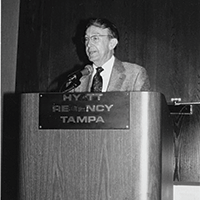
Harold R. Roberts, MD, chaired MASAC
during the HIV/AIDS crisis in the 1980s.
Six years after Betty Jane and Robert Lee Henry founded NHF, MASAC was established in 1954. “The Henrys needed to bring together a group of experts in the field, physicians willing to treat these patients and come up with recommendations as to how to treat them,” says Frick. Among those patients was the Henrys’ son, Lee, who had hemophilia. The vision—to connect physicians and researchers to discuss challenges in care—is largely why advances are still being made in this field decades later.
Among the council’s former members and chairs have been pioneers in bleeding disorders research. Kenneth Brinkhous, MD, the first chair of MASAC, isolated factor VIII, the blood-clotting protein lacking in those with hemophilia A. In the mid-1960s, Judith Graham Pool, MD, also a member of MASAC, discovered that cryoprecipitate, created by thawing plasma, was not only rich in factor VIII but also more effective and reasonable to administer than previous methods. Both of these milestones were major breakthroughs in the care of patients with hemophilia.
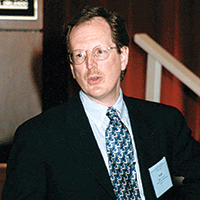
Keith Hoots, MD, chaired MASAC
from 2001 to 2007. As treatments and screening methods have expanded and improved, MASAC has regularly communicated these advances to the medical and patient community. The group has also served a crucial role in disseminating information through times of turbulence. One such period was the HIV/AIDS crisis of the early 1980s, which profoundly affected the bleeding disorders community.
Harold R. Roberts, MD, was a member of MASAC in the 1980s, and served as chair from 1988 to 1994. He was chief of the Division of Hematology at the University of North Carolina at Chapel Hill, and director of its Hemophilia and Thrombosis Center until his retirement seven years ago. “There was a crisis about what to do, especially immediately,” Roberts recalls. As the medical community realized that HIV could be spread through blood products, the enormity of the problem became gut-wrenchingly apparent. If even one plasma donor was infected with HIV, the entire batch of factor product (which was manufactured through the pooled plasma of thousands of donors) could easily become contaminated. Frequent recipients of clotting factor products, such as those with severe hemophilia, were at particularly high risk. Tragically, nearly 90% of Americans with severe hemophilia became infected with HIV/AIDS during this time.
In a 1995 report called HIV and the Blood Supply: An Analysis of Crisis Decisionmaking, the Institute of Medicine (IOM) highlighted the communication efforts of NHF and MASAC during this period. The report stated that it “served a crucial function as an intermediary” between scientific and medical organizations and physicians, and between users of blood products. With the advent of safer recombinant clotting factors in the late 1980s and 1990s, MASAC played a role in communicating these new therapies to consumers and providers, and detailing how to use them. “They were not derived from human plasma,” explains Jeanne Lusher, MD, who was a member of MASAC at the time. She became chair in 1994. She is a distinguished professor emeritus of pediatrics at Wayne State University School of Medicine in Detroit, Michigan. MASAC addressed many questions, such as what to do with plasma-derived clotting products and who should be receiving the new recombinant products, Lusher says.
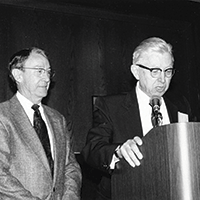
Harold R. Roberts, MD, (left) served as
chair 1988 to 1994; Kenneth Brinkhous,
MD, (right) was the first MASAC chair.
Today, the council continues to foster communication within the clinical community and accelerate progress for patients. But the patients themselves and their connection to MASAC play a role in that success, too. “I think the advances in hemophilia were made possible by the fact that there was such a close association between patients and the medical community,” Roberts says. People with bleeding disorders and their families make excellent partners in this progress, says Jain. “They tend to be well-educated, well-informed consumers,” she adds.
A Lasting Impact
The recommendations issued by MASAC are products of their time, notes Lusher. In every meeting, the group must determine the foremost concerns for which people want guidance.
Here is a sampling of some of the council’s achievements that have had a tremendous impact:
- Participated in the establishment of hemophilia treatment centers (HTCs). There are currently 135 HTCs nationwide, funded by the CDC and MCHB. “Seventy percent of patients who have hemophilia are treated through these,” says Frick.
- Expanded the community to serve all people with various bleeding disorders.
- Introduced major initiatives for women with bleeding disorders.
- Encouraged testing and treatment of hepatitis C virus (HCV) in all patients. Complications from HCV infection, such as liver failure and liver cancer, are the leading cause of mortality in the bleeding disorders community, but there are now better treatments to cure it.
- Communicated the introduction of safer recombinant clotting factors following the HIV/AIDS crisis.
- Issued guidelines for what should be done as children transition to teenage and adult life.
- Released recommendations for women who were carriers of hemophilia and could hemorrhage after childbirth.
- Communicated the advent of genetic counseling to identify carriers of hemophilia.
- Advised the public on the availability and safety of clinical trials for gene therapy and how they should be conducted so patients would get optimal care.
- Shifted from patients being treated on-demand to more prophylactic regimens. MASAC recommended that prophylaxis begin as early as possible in pediatric patients to prevent chronic joint damage and other secondary complications later in life.
- Created the first US guidelines on von Willebrand disease through the NHLBI.
- Established standards of service for pharmacies distributing clotting factor.
- Issued a statement encouraging a rigorous vetting process for biosimilars, products patterned after clotting factor concentrates.
- Released recommendations on testing and surveillance for inhibitors (antibodies produced by the immune system that can prevent the infused clotting factor from working properly).
In addition, Pipe says there’s even more to be proud of. “The work of MASAC members goes so much further than the recommendations that end up on the website,” he says. Outside of their regular jobs and engagement with clinical care and research, they contribute to the overall working of NHF to a great degree, he says. MASAC members serve on committees, spearheading initiatives that drive major research studies, plan national summits to deal with specific subjects, and award NHF grants and career development awards.
“It’s a group of volunteer individuals who really go above and beyond to give back to this community,” Pipe says.

